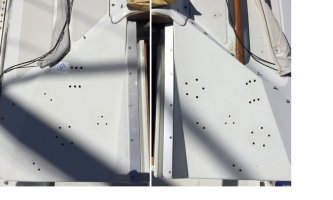I'm starting to remove/replace some of the deck hardware on either side of my companionway. New winches, new clutches and slightly different alignments due to larger winch drums. Etc.
Net of it is, I'll end up filling roughly 30 fastener holes.
I would "normally"
-- drill out the holes
-- ensure that there is clean surface (plywood) inside
-- slightly over-drill the underside
-- tape/seal the bottom of each hole
-- mix up a batch of WEST-system epoxy, thickened to about the consistency of mayonnaise
-- splooge it in there, making sure there are no bubbles or voids
-- when cured, sand/fair/etc.
In *this* case, though, I want to try to have the finished surfaces gelcoated to match as much as possible.
It's an area that will literally be right in front of my eyes every time I'm on the boat, and I want it to look nice. Or at least, not bug me.
I've talked to a gelcoat guy at the local yard, who can color-match it for me. I'm color-blind, so I *know* that's not the job for me.
But he mentioned that gelcoat won't bond with epoxy, so I need to fill the holes with thickened polyester resin instead of epoxy.
.... and I've been using epoxies so long I don't remember what thickening agents are good with polyester.
Old school, I'd buy a half-pound of 1/16" or 1/32" chopped glass strands and thicken to suit. But are there better thickening agents to use? Or is colloidal silica good with polyster? Can I use WEST 406 with polyester? Or... should I use something else?
Bruce
Net of it is, I'll end up filling roughly 30 fastener holes.
I would "normally"
-- drill out the holes
-- ensure that there is clean surface (plywood) inside
-- slightly over-drill the underside
-- tape/seal the bottom of each hole
-- mix up a batch of WEST-system epoxy, thickened to about the consistency of mayonnaise
-- splooge it in there, making sure there are no bubbles or voids
-- when cured, sand/fair/etc.
In *this* case, though, I want to try to have the finished surfaces gelcoated to match as much as possible.
It's an area that will literally be right in front of my eyes every time I'm on the boat, and I want it to look nice. Or at least, not bug me.
I've talked to a gelcoat guy at the local yard, who can color-match it for me. I'm color-blind, so I *know* that's not the job for me.
But he mentioned that gelcoat won't bond with epoxy, so I need to fill the holes with thickened polyester resin instead of epoxy.
.... and I've been using epoxies so long I don't remember what thickening agents are good with polyester.
Old school, I'd buy a half-pound of 1/16" or 1/32" chopped glass strands and thicken to suit. But are there better thickening agents to use? Or is colloidal silica good with polyster? Can I use WEST 406 with polyester? Or... should I use something else?
Bruce
Last edited:

